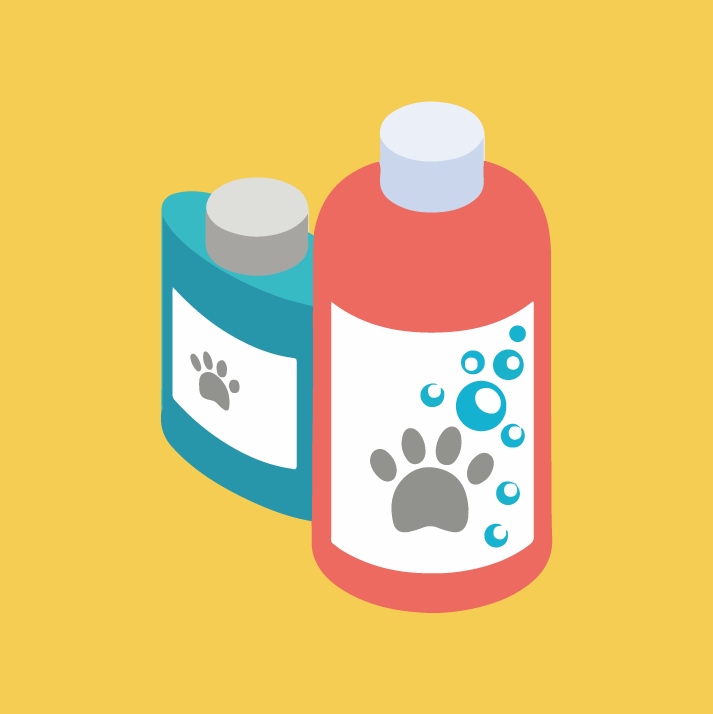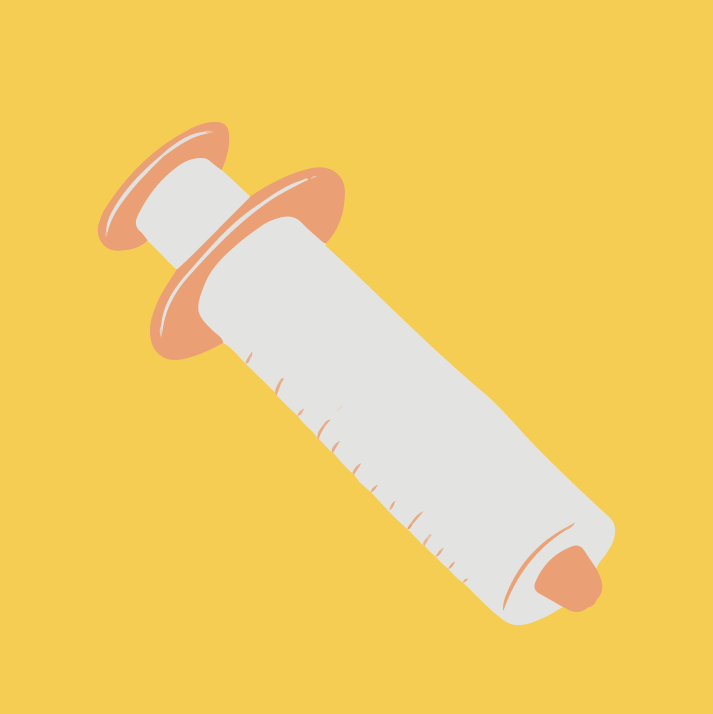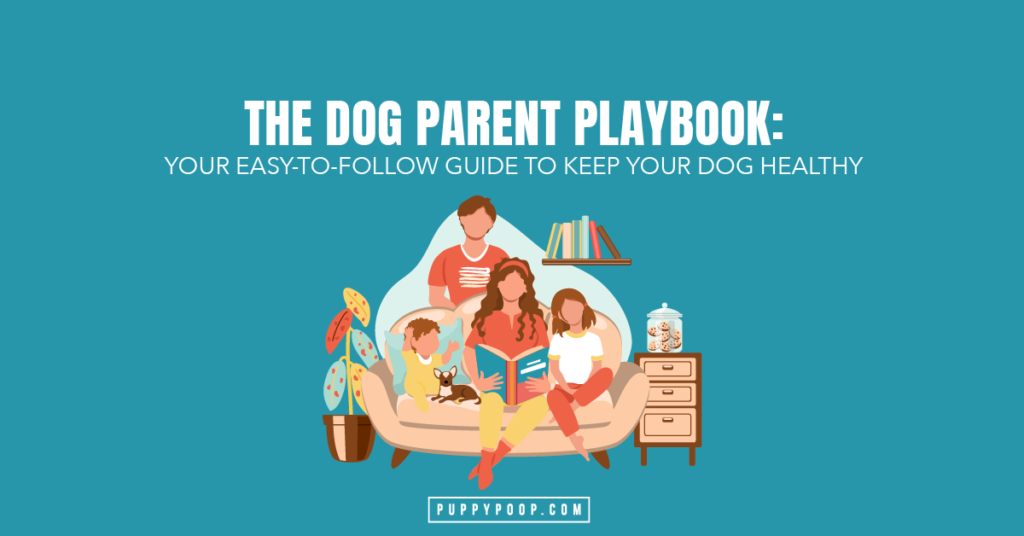
How do I keep my dog healthy? It’s a big question at the top of most parents’ minds.
At PuppyPoop.com, our team talks to dog owners at all stages every day. We talk to young families bringing home their first puppy. We talk to veteran shelter workers who’ve fallen in love with their 9th rescue dog and everyone in between. Whatever stage of life you (or your dog) is in, you have one thing in common with others who have furry friends in their home: A deep wish for your dog to be as healthy as possible for as long as possible.
That’s why we’ve created the Dog Parent Playbook, to give you a go-to answer when you need it. We hope this will be a bookmarkable reference guide for you to assist in keeping your dog healthy their whole life.
But wait, who the heck are we?
Who is behind the Dog Parent Playbook?
Oh right!
We’re Jess & Tara, founders of DIG Labs and the editors behind the site you’re on right now. We think that the dogs that come into our lives are so much more than pets, they are a part of our families. That’s why we curate the latest in animal research to give you solid, timely resources for how to help your pup thrive for their whole lives. Whether through our app, by text support, or in an informative article, we’re bringing you answers you can trust.
Ever since we started Dig Labs, we’ve fielded questions about how to keep our furry friends from having a crisis in the first place. We talk to dog parents about food choices, training ideas, and how to bring home a new pup. We work with rescues, veterinarians, scientists, and supplement makers to find those answers. And, we decided to compile as much of what we know as we can here so it’s easy for you to reference any time.
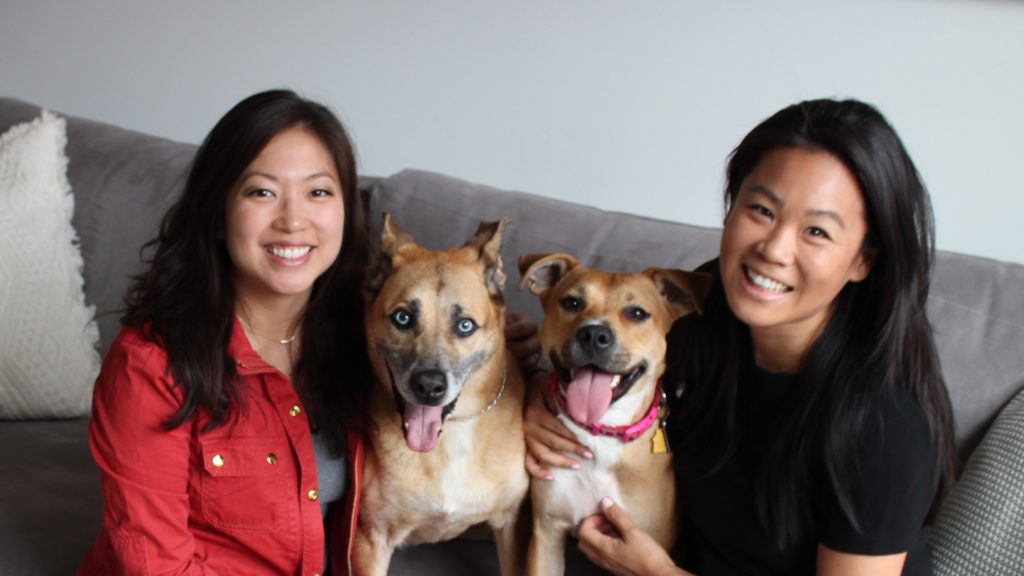
How to Use The Dog Parent Playbook
There are two components to this guide:
- This extensive, bookmarkable guide. We update this guide constantly when new information becomes available, so we recommend bookmarking this page.
- A downloadable quick reference guide that you can print or save for use in-the-moment.
Use the navigation buttons below to quick-jump to the section you need today. Or, if you’ve got some extra time, take a meander through the whole guide. Whichever works best for you, we’re glad you’re here and encourage you to pass on this guide to your fellow pet parents!
Bringing home a new dog in a healthy way in 7 simple steps
There’s a lot to consider when it’s time for a new furry friend to join your family. Keep in mind that needs can vary for puppies versus older dogs. Another variation is whether or not your new addition came from a traumatic background. Just like humans, some dogs need a little more patience early on to overcome special circumstances and challenges. As best as you’re able, try to get a complete picture of what life was like before your new pet came into your family. Then, take these steps before day one with your new canine companion…

Step One: Gather needed supplies for your home.
This is especially important if you don’t have pets in your home currently. The most critical items to gather for your new addition are:
- A leash, color or harness, and ID tag that are appropriate for the size and breed of dog you’re bringing home.
- A crate, bed or old blanket/towels, and possibly gates. Dogs need their own place and strong boundaries. Crate training from day one will help your pup feel safe and make time away from home easier for both of you.
- Bowls, food, and toys that are familiar, if possible. Speak to the group your dog is coming from about what type of food they are eating and what toys your pup likes best.
Step Two: Dog Proof Your Home
Especially early on, life with a dog can mean adapting to some of the hazards around your home. Remove easy-to-access breakables and put away anything valuable that could potentially be chewed.
In addition to putting up your favorite heels or running shoes, look for plants, food-type items, or other close-to-the-floor items that could be a problem. We recommend sitting on the floor in rooms your dog will be allowed into and considering things from their angle.
Step Three: Setup Your Dog’s Domain
Decide where their crates, water bowls, and other supplies will live. This is particularly important for a rescue pet, which sometimes has specific needs to be safe. Ask your adoption center if there are any known past traumas or preferences you can accommodate.
Step Four: Determine How You’ll Get Your Dog Home
Many new dog parents think a lot about setting up their home but forget this important step! Think about what type of carrier you will need and where your pet will ride in your vehicle.
While you’re at it, consider who is going with you to pick up the dog. This is often an exciting time for families, but it’s worth considering whether a car full of family members and/or friends will make the first ride extra stressful for your dog.
Step Five: Introduce Your Dog to Family Members Outdoors
Instead of bringing the whole family for pickup, consider having immediate family members at home. Then, make introductions one at a time outside.
Learn more about introducing your dog to other pets. Click the button below.
Step Six: Give the Dog A Tour of Your Home On A Leash
Even if a dog has been previously house trained, they need to be trained on your home and your rules. Don’t immediately release them into their new home. Instead, take the time to take your dog on a grand tour, just like a very special guest. Go room-to-room and establish where their space is as soon as you can.
Step Seven: Offer Plenty of Quiet, Downtime to Help Your Dog Settle In
Homecoming days can be tempting. We want to play with our new furry family members all day long. But, in the first few days, a new pet needs plenty of quiet time to learn about their new space and rest. Encourage children and other family members to help your pup settle in by giving them their space, initially and wherever needed.
The First Days of Dog Parenthood: Follow the Rule of 3
Like so many other things, the way we begin with a new dog should match the way we wish to go on. If at all possible, take the space needed to help your dog acclimate to life with your family. Just like humans, new experiences can be scary for your pet. To help them adapt, use the Rule of 3 which has been a long-standing way shelters have framed helping your pet adapt for new families.
The First 3 Days: Everything is brand new (and a little scary)
It is likely that your dog will feel overwhelmed when everything is new. Don’t be surprised if they don’t eat or drink as much as you would expect. Your dog isn’t themself yet, and that’s totally normal. This is a time to…
- Gather Supplies. Bringing home a new pet can be stressful. Make sure you have what you need ready to go in advance so you have one less thing to think about as you get to know each other.
- Begin training and establishing house rules using positive reinforcement training, which relies on dog psychology to reinforce routines and boundaries.
- Acclimating your pet to your home (stairs, apartment, etc).
- Begin potty training/retraining. Even if your dog has previously been potty trained, there will be some transition time with a new home.
- Establish a feeding schedule. It’s best to do this right from the beginning in the same way you wish to go on.
After a couple of days of getting to know your home and testing boundaries, your dog will begin to settle in. But everything is still very new. Be patient, but firm in your boundaries. Like children, loving boundaries help dogs learn and grow strong.
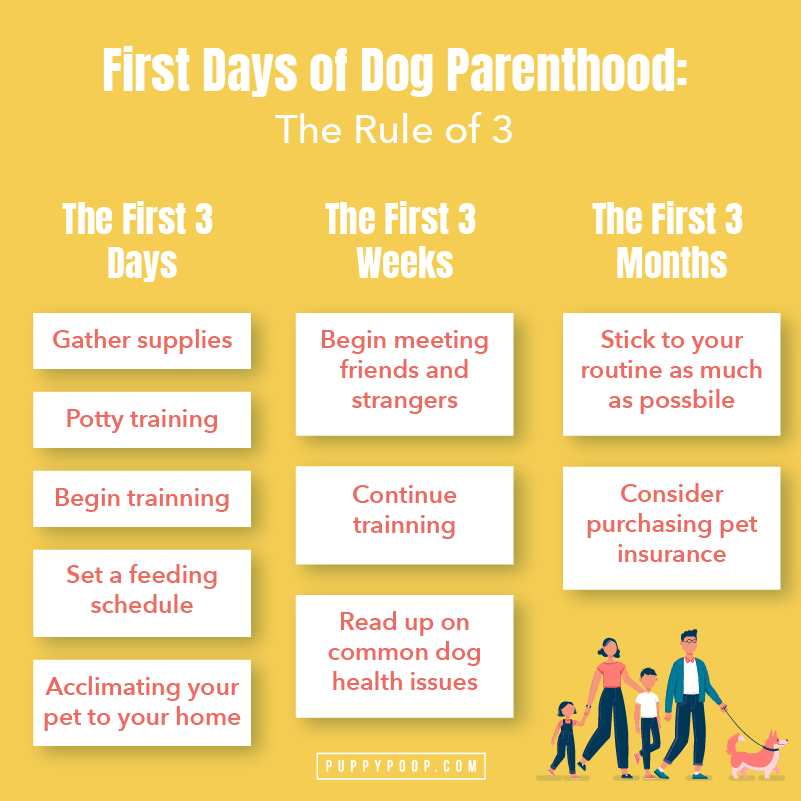
The First 3 Weeks: A New Dog Begins to Settle In
At this point, a dog is beginning to understand that your home could be forever. This is where any behavior issues are likely to show themselves and it’s a critical time for establishing boundaries, training, and getting to know your pet’s personality. During the first few weeks, you can…
- Begin meeting friends and strangers. A great time to do this is on your walks through the neighborhood. Ideally, meet and greets happen outdoors.
- Continue training and consider working with a professional dog trainer. It’s easiest to establish new routines and boundaries right upfront.
- Read up on common dog health issues like diarrhea. That way you know what to do when it happens. Don’t get caught off guard.
By the time your dog has been a part of the family for a whole month, a routine is beginning to develop. But the newness isn’t over yet. Be patient and continue to get to know each other.
The First 3 Months: Safety and Routine Are Established
By the end of your first three months, the relationship and routine is firmly established with your new dog. This critical time for bonding and connecting has hopefully helped you to establish a sense of security with each other. A few things to consider at this time…
- Stick to your routine as much as possible. Dogs are creatures of habit. Keeping them on a well-established routine is the fastest way for them to learn.
- Consider purchasing pet insurance. For many, it’s a worthwhile investment for peace-of-mind if there’s an emergency and you don’t have emergency savings for your pet.
With love and patience, most dogs will be acclimated well to their new lives in the first three months. Of course, some pets with special circumstances might need a little more or less time. Be flexible and open to the process that is right for you and your dog.
Shopping for Your Dog: A Go-To List to of What to Keep On- Hand At Home
There are so many things available at your local pet store and online that it can be difficult to keep up with what’s important to have at home to keep your dog healthy. So, we’ve done the work for you! Below is a critical shopping list for dog parents, complete with our most up-to-date recommendations for products we love.
*Some of the links included below are affiliates.
Feeding Items
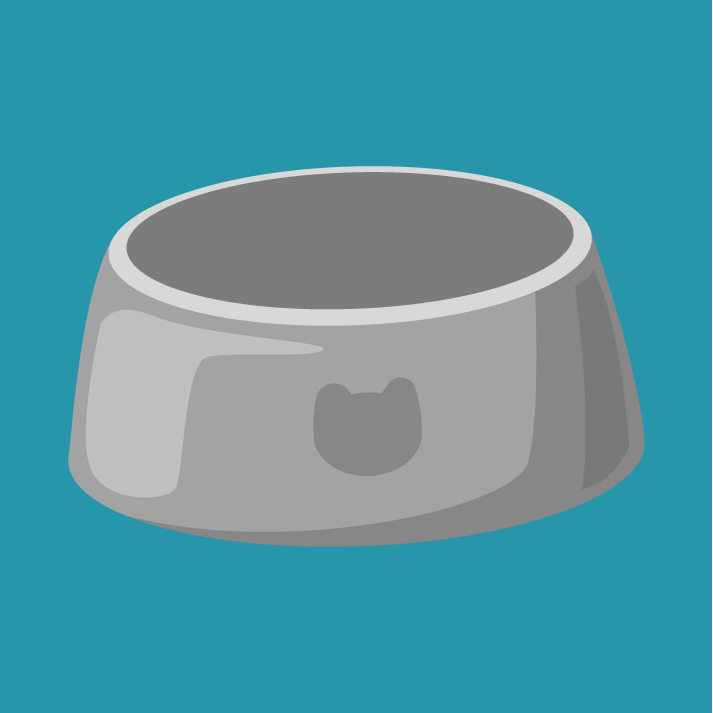
Stainless Steel Bowls
We love stainless steel bowls for our pets because they are easy to clean and the rubber bottom helps them from slipping all over the floor. You’ll thank us later!

Slow Feeder Bowls
Puppies LOVE to eat. Slow feeder bowls help them slow down while eating — preventing upset puppy bellies.

Glass or Stainless Steel Food Storage Containers
These containers keep your dog food fresher longer. Who doesn’t love that?
Beds & Crates

Old Towels or Bedding
These are perfect for setting up your dog’s crate. Because they’re old, it’s okay if they get messy, and your dog will like that they smell like you!

Crate of the Right Size
It’s important for your dog to have their own place to sleep. Make sure to pick one that matches the size of your dog.
For Going Out
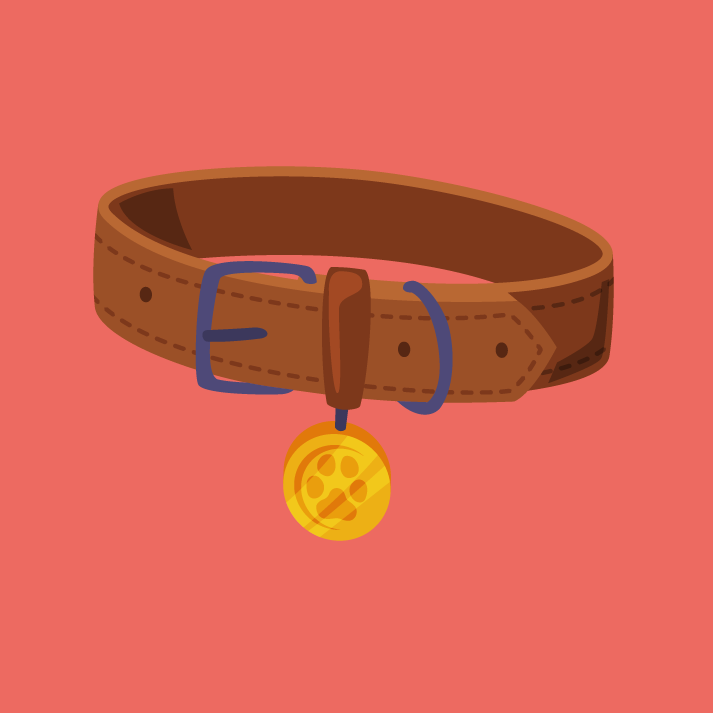
Collar or Harness
For the safety of your pet, it is important to get them a collar and/or harness that properly fits. They will love when you use it to take them on walks and adventures!

Pet ID (attached on flat collar)
An ID tag attached to your pet’s collar is crucial. Make sure it has their name and your contact information in case they get loose.
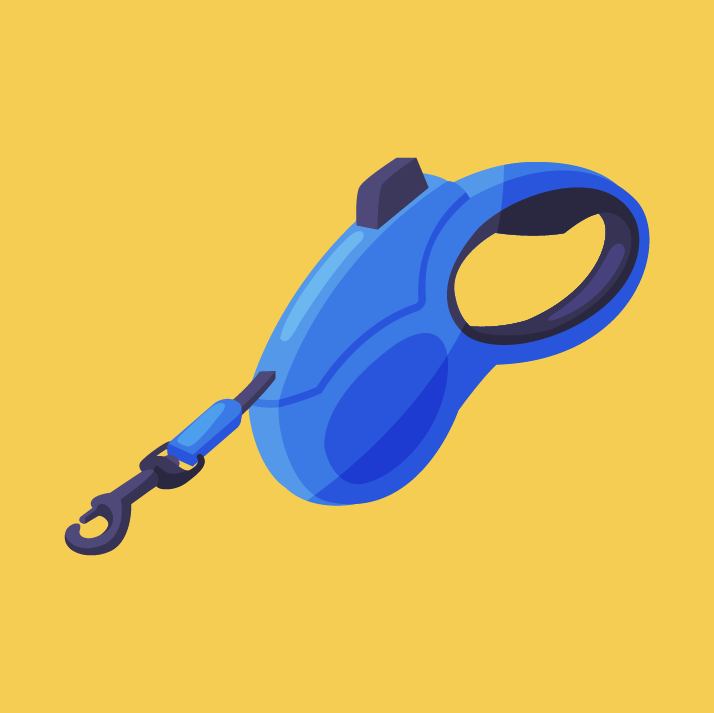
Leashes (at least two)
It’s important for your dog to have their own place to sleep. Make sure to pick one that matches the size of your dog.
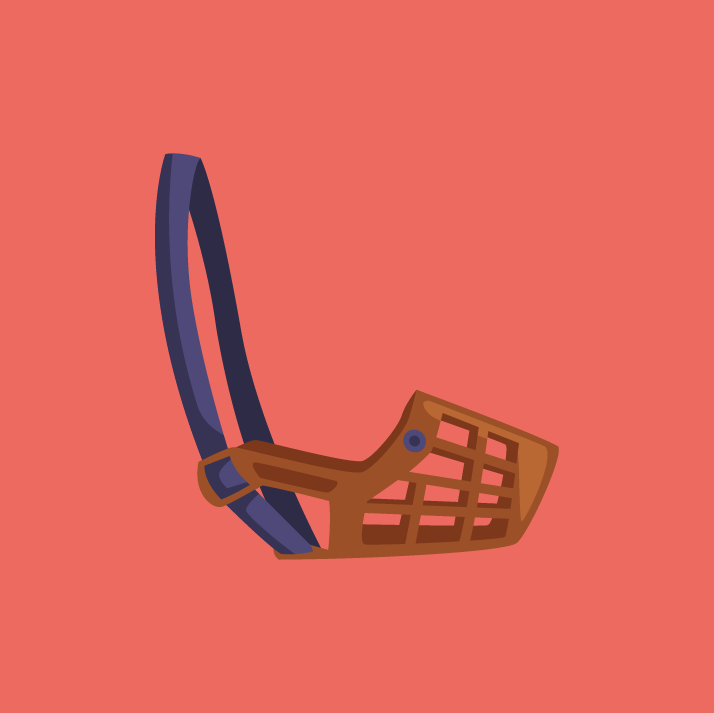
Basket Muzzle (if needed)
Having a muzzle is useful in case your dog doesn’t do well with other animals, or for preventative measures, while out and about.
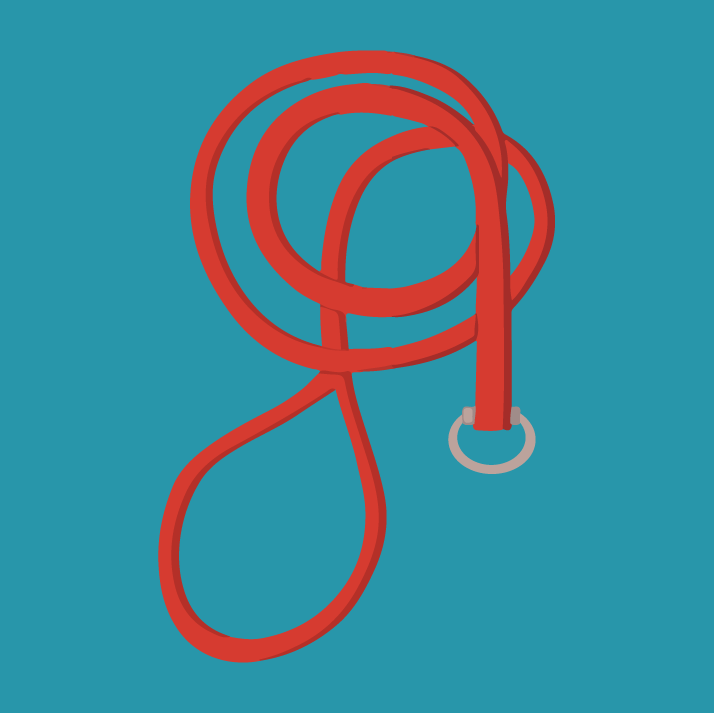
Emergency Slip Lead
Useful to keep around in case your pet gets loose, or if helping a stray animal.
Toys & Treats
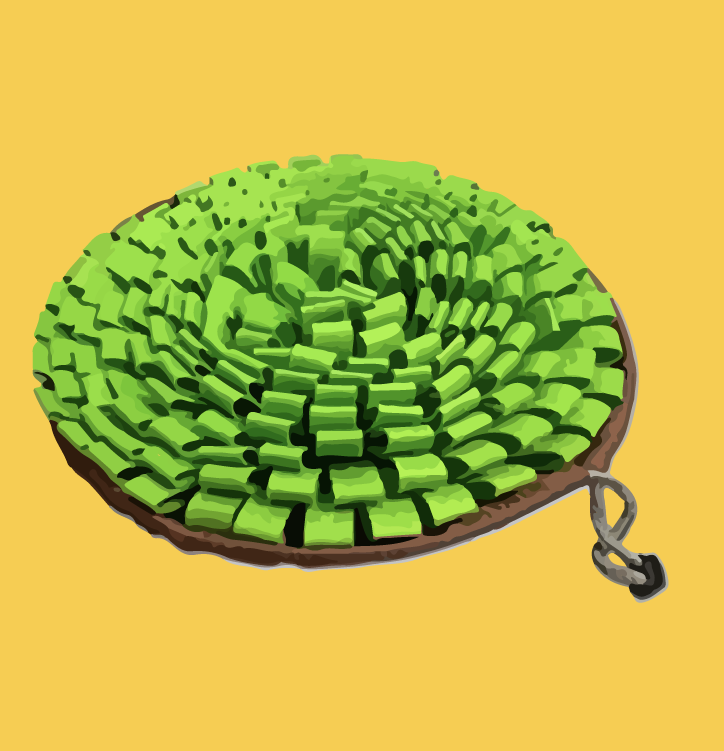
Snuffle Mat
It’s important to keep your dog’s brain active. Use a snuffle mat to hide treats/food in and let them use their mind to sniff them out!

Puzzles
Same as the snuffle mat, puzzles keep your dog’s mind active and keeps them busy.

Balls
What dog doesn’t love a good game of fetch? This will keep your dog active and happy.
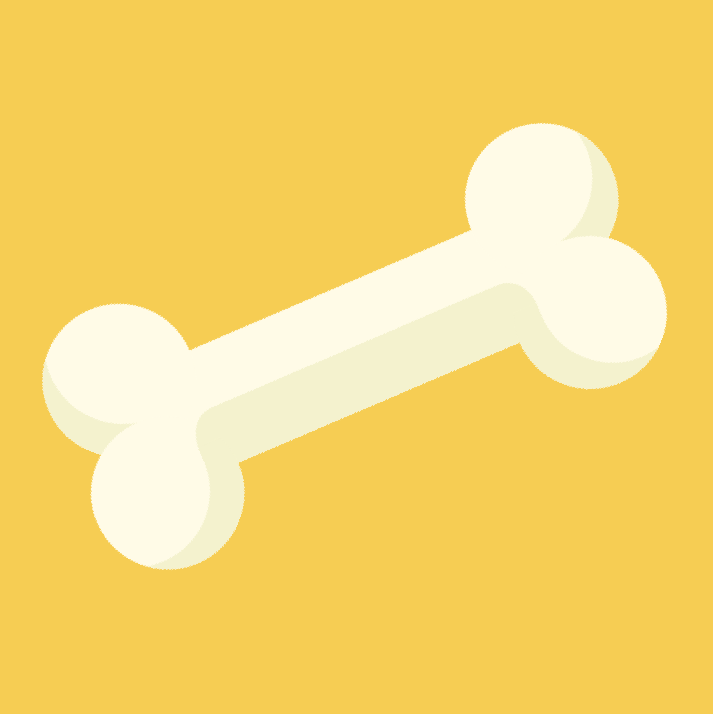
Raw Meaty Bones
We love this type of treat because it isn’t harmful to their digestion and keeps them busy.
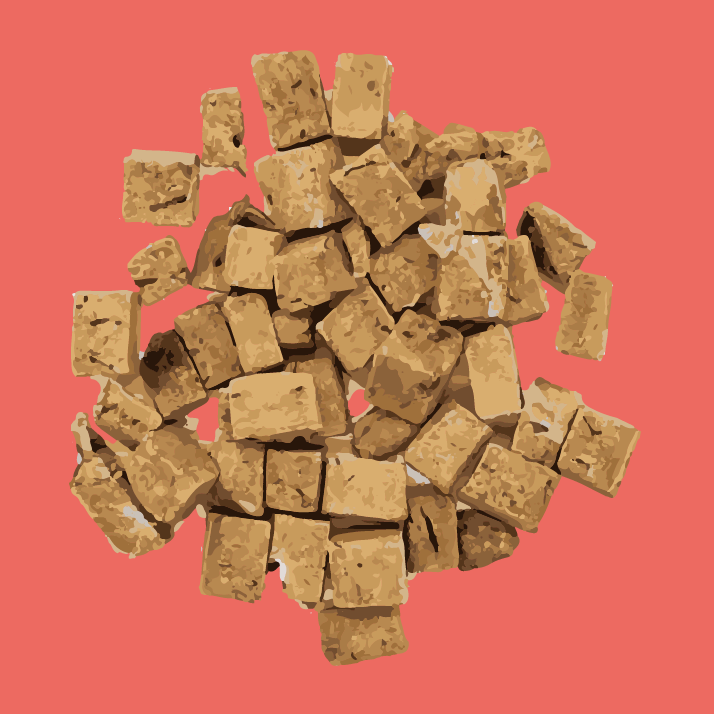
Air Dried Chews w/o Bones
Another safe option to reward your dog with!
Flea, Tick, & Heartworm Prevention

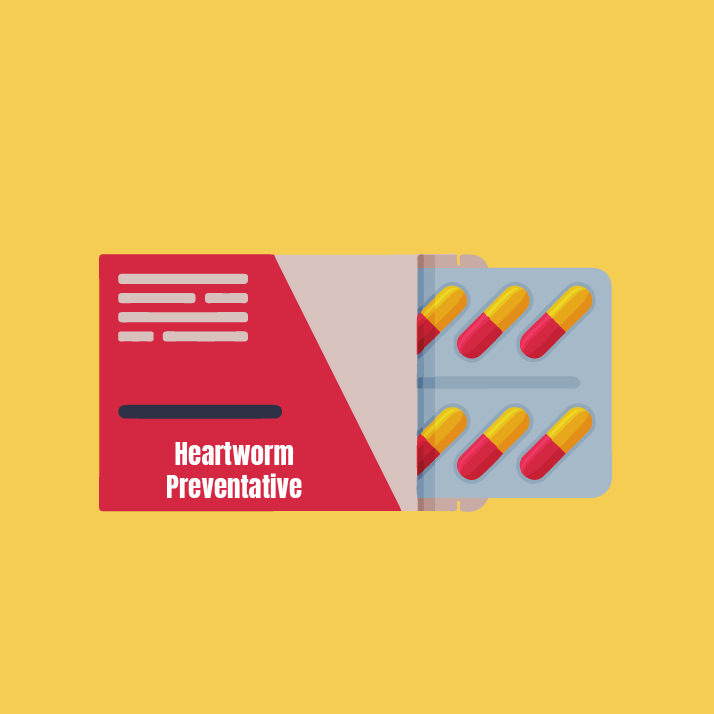
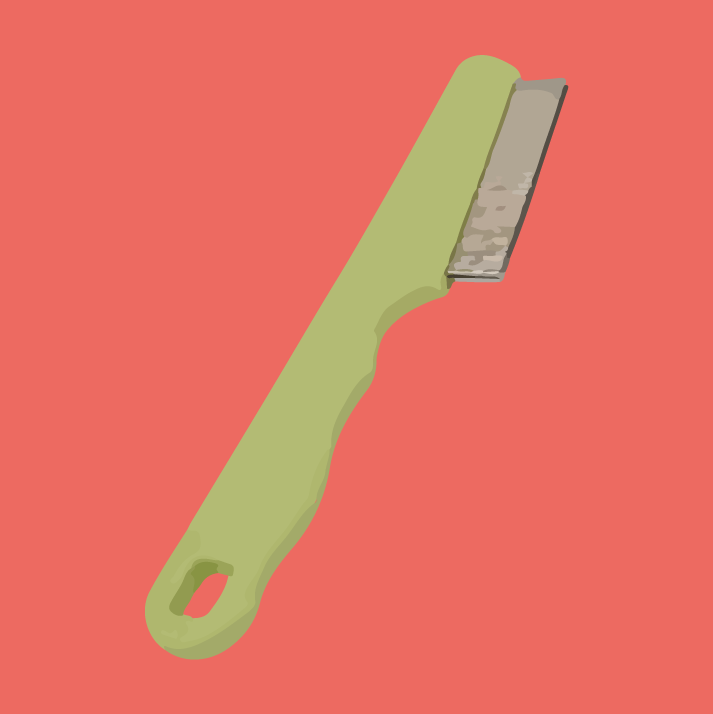
Flea & Tick Comb
If your dog happens to have fleas or ticks, a comb specifically for this can come in handy. The fine teeth help remove the pesky critters and detangle your dog’s fur.

Grooming Products
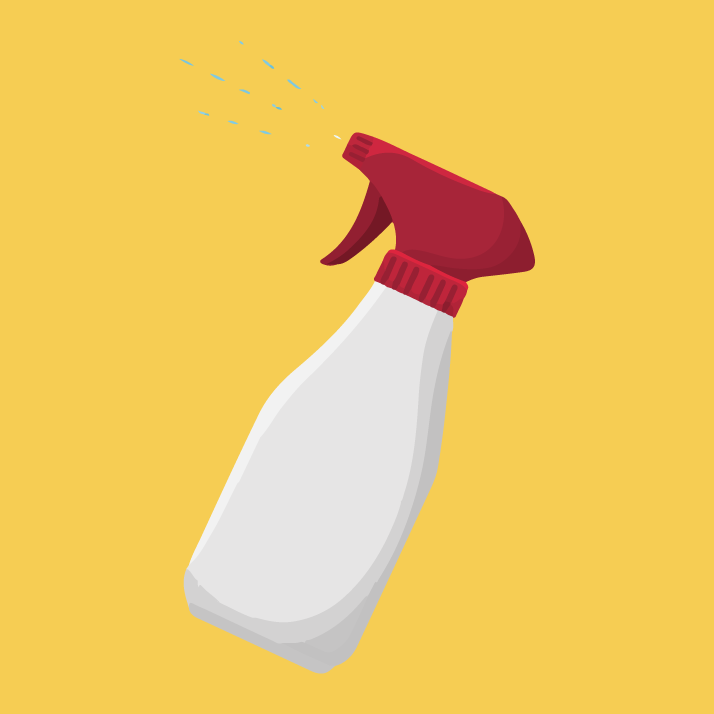
Nature’s Miracle Stain Remover
Having a dog comes with some mess. We love using Nature’s Miracle for stain and odor removal on fabrics and rugs in our homes.

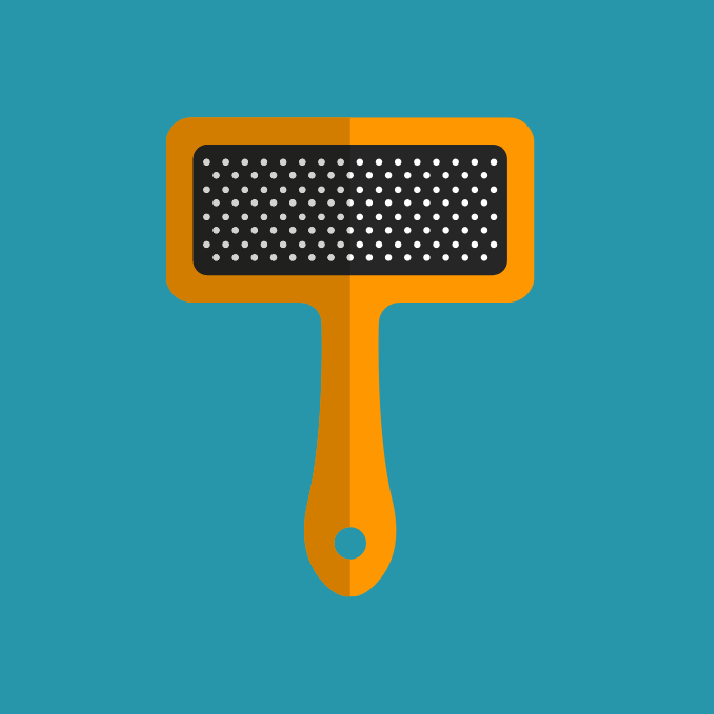
Brush
Many dogs shed and if they don’t they probably need their fur detangled. You can’t go wrong with the Furminator!

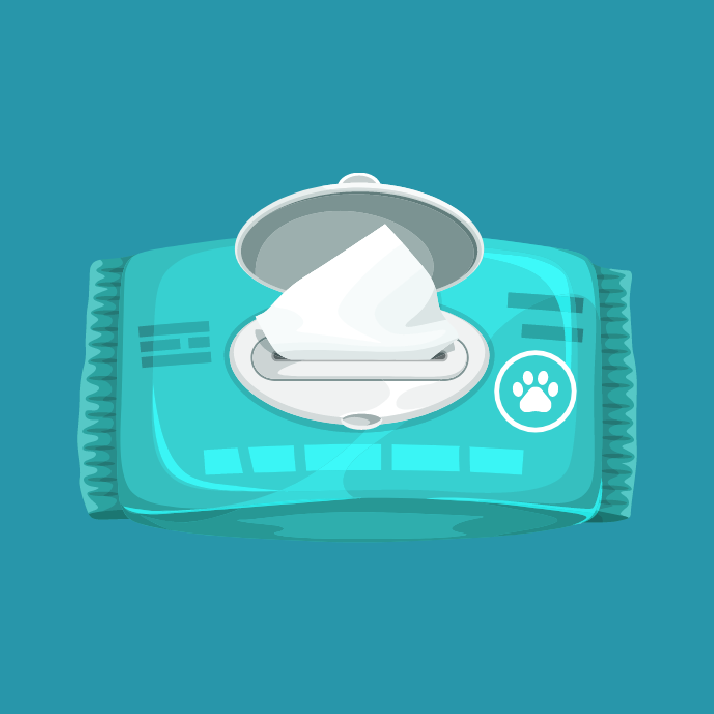
Paw wipes
Dirty paw prints on a clean floor are not our favorite. Use these wipes to quickly clean their paws and save your sanity.
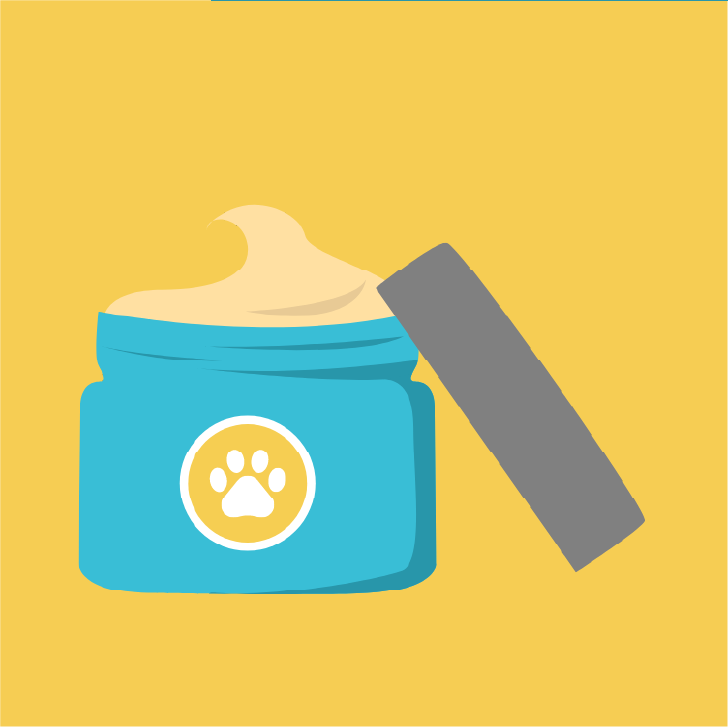
Paw Balm
Your dog’s paws can become dried, or even cracked, due to hot pavement or weather. Use this balm to soothe and hydrate those cute puppy pads!
Healthy Living
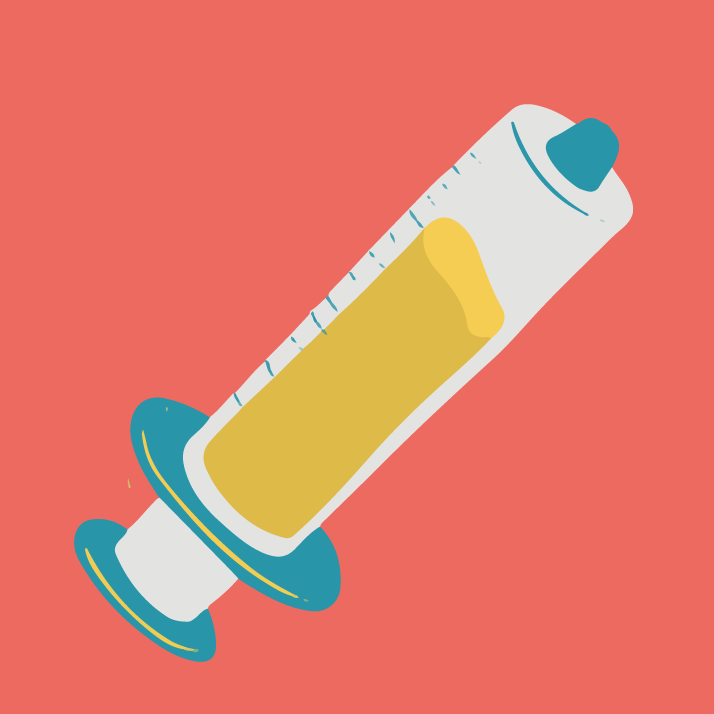
DiaGel (Small dogs, Medium dogs, Large dogs)
A useful syringe to keep around to help with your dog’s intestinal tract.
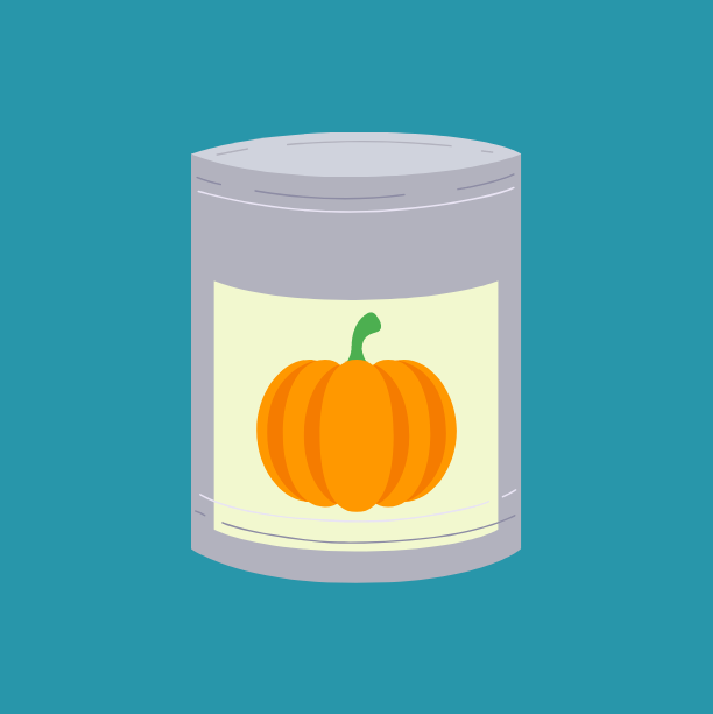
Plain Canned Pumpkin
Pumpkin is full of fiber and helps with dog digestion — especially if they are experiencing diarrhea.

Thermometer
Just like with kids, having a thermometer for your dog is important. This will help you monitor their temperature if you believe they are getting sick.
How to Choose Dog Care Professionals to Help Keep Your Dog Healthy
It’s essential to have a good relationship with a veterinarian and other pet professionals who help take care of your dog. So, we’ve collected some simple tips to help you choose professionals to help you with training, pet sitting, and of course veterinary care.
3-Steps to Choosing a Veterinarian
Choosing a veterinarian doesn’t have to be daunting or expensive. The AVMA advises following these three steps to help you pick the right vet for you:
- Ask for a referral if you can. Friends, breed-specific groups, and shelters are all good sources of first-hand information about what the best choices are for veterinary care in your area.
- Pay a visit before committing to care. Just like when choosing your own doctor, it’s a good idea to visit the clinic before setting your choice. Ask about hours and fees. Observe the way the office staff interacts. Check for cleanliness and a feeling of safety. Nothing is better than seeing for yourself.
- Check credentials, insurance, and licensing. Make sure your chosen veterinarian is properly licensed, insured, and trained in any needed specialties.
Once you have your chosen veterinary clinic, it’s a good idea to ask for a recommendation for emergency care, if your vet is not available and there is an incident.

Choosing the Dog Trainer That’s Right for You
Since dog training is unlicensed and non-regulated, it can sometimes feel tricky to know if you are choosing the right trainer. To help you choose look for these critical cues:
- Find a trainer that uses positive reinforcement and rewards-based training. Ideally, your trainer will (and will teach you to) use food as the primary reward. Although it is possible to use other forms of positive reinforcement, food is the most common and easiest to practically implement.
- Look for the right professional designations. These include the following: CTC, KPA CTP, VSA-CDT, VSPDT, CCPDT, PPG, IAABC, and PMCT. These designations provide evidence that the trainer you’re considering has been tested, spent plenty of time learning, and keeps up with professional changes.
- Ask for references from past clients. Speaking to others who have worked with the dog trainer you’re considering is a great way to understand their methods from the client’s perspective. And, a trainer who won’t provide references is likely one you want to avoid.
Long Term Routines to Keep Your Dog Healthy
Things will go wrong. There will be diarrhea. Your pup might chew your favorite pair of All Birds. Don’t worry! Every dog parent has been there. Thankfully, by keeping up these regular routines you can lessen issues and make sure your pup is happy and thriving. We recommend adding the following to a recurring checklist or calendar:
Things will go wrong…. Don’t worry! Every dog parent has been there.
Keep Up with Vet Care
Just like most healthy humans, your pup needs regular checkups. Visit your veterinarian once or twice per year. And, make sure to keep good digital records of your dog’s health complete with regular stool tests to share with your vet at your visits.
Be consistent in your food choices.
Find the best choice for your dog and your budget. And, if things change with your dog’s digestion, evaluate the food mixes. Supplement when needed. Think about homemade, wet, dry, or natural dog foods and feed your pup the healthiest diet for their unique needs. Like humans, dogs thrive on good nutrition.
Set up a solid plan for when you’re away.
Keep emergency records up to date including a backup emergency contact. And, don’t forget to keep up with crate time so your pup is in the routine of being crated.
Head outdoors every day. It’s good for both of you!
Make sure your dog gets plenty of time outside. It’s critically important to play outside, for the whole family! Have fun together, with toys like puzzles or balls. And, no one is likely to realize they’re exercising.
Whatever stage of dog parenthood you’re in, we hope this resource was helpful. For additional support, please grab your copy of the downloadable and printable checklists and resources by clicking the button below.

